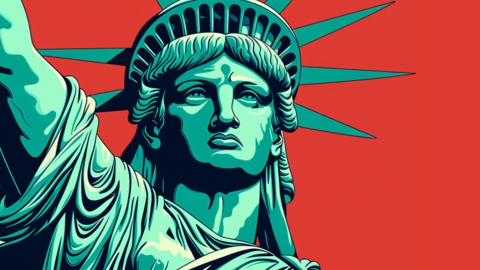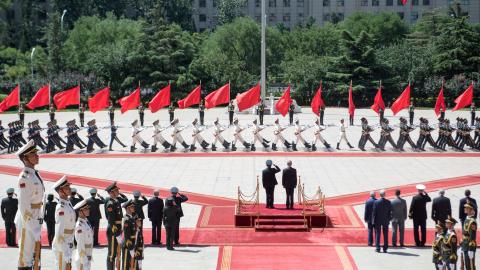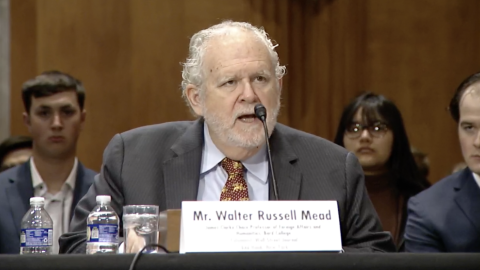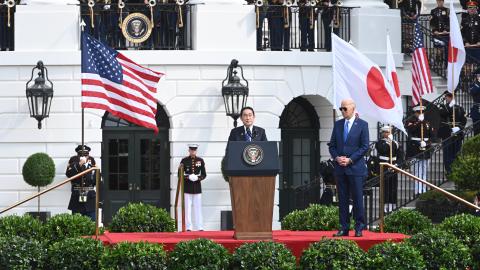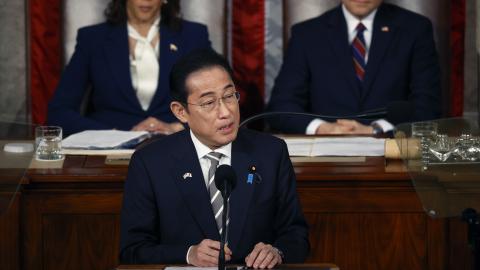Washington is hardly the nation’s glamor center, and even so, visits by foreign dignitaries usually produce more style than substance. Japanese prime minister Fumio Kishida’s state visit this week, however, was one of the most consequential in years. The understated leader of America’s largest Asian ally announced a series of agreements with President Biden that were unimaginable a few years ago. Japan’s quiet revolution in foreign policy is altering Asian politics and thwarting Xi Jinping’s dream of dominating the region.
The U.S.-Japan alliance underwent a major tune-up this week to address China’s growing threat to the region. New command-and-control arrangements will allow the Japanese and American militaries to collaborate much more closely and respond more swiftly to Chinese actions. The two countries will build more weapons together, and Biden will ask Congress to authorize Japanese shipyards to repair American ships so they can get back in the fight faster. They also met with Philippines president Ferdinand Marcos Jr. to discuss how to best respond to China’s aggression in the South China Sea. As Kishida told Congress on Thursday, Japan has transformed “from a reticent ally, recovering from the devastation of World War II, to a strong, committed ally, looking outward to the world.”
These changes have been a long time coming for Tokyo, which awoke to the danger posed by China much earlier than Washington did. When he started his second term as prime minister in late 2012, Shinzo Abe saw that China’s growing strength spelled trouble for the region. He began preparing his country for the challenges to come and used Japan’s diplomatic and economic toolkit to counter Chinese influence in Southeast Asia. With its usual discernment about geopolitics, the Obama administration feared that Abe was a throwback to Japan’s World War II-era militarism. As Xi Jinping unrolled his plan to dominate Asia, Secretary of State John Kerry said that “the biggest problem in Asia” was Japan.
Abe had another immense obstacle in his way: Japan’s constitution. During the brief period after World War II when liberals hoped that United Nations resolutions would peacefully resolve most international disputes, the American administrators of postwar Japan demanded that the new constitution renounce war and forbid the government from maintaining a military. But as the Cold War got underway, the Americans quickly realized their mistake, and subsequent Japanese governments creatively reinterpreted the constitution to adjust to international realities. For example, Japan does not have an army, navy, or air force, but it does have Self-Defense Forces with tanks, fighter jets, and so-called helicopter destroyers that can carry F-35s.
Even so, Japanese public opinion was dead set against many of the military reforms that Abe wished to make. He was able to increase defense spending somewhat and push through a bill authorizing Japan’s Self-Defense Forces to defend American assets being used to defend Japan, but even those required difficult political fights. He left office due to health reasons without fulfilling his larger ambition of amending Article 9, the pacifist clause in Japan’s constitution.
For most of his career, Kishida was not a China hawk, so his hard stance in office came as a surprise to many. But a combination of factors upended Japan’s strategic outlook: China’s treatment of the COVID outbreak showed even the doves that Beijing was a source of geopolitical risk, Russia’s invasion of Ukraine made clear the threat of major war was real, and Xi Jinping’s belligerence brought the danger to Japan’s doorstep. Even Komeito, a pacifist party that has partnered with the ruling Liberal Democratic Party since 1999, agreed that Japan needed to change course.
Japan has historically moved fast when it feels threatened, and this time is no exception. Its defense budget will double by 2027. Much of the spending is going toward the kinds of weapons and spare parts that its forces will need if a conflict breaks out soon. More significantly, Tokyo is buying Tomahawk missiles that will allow Japan’s military to hit targets up to 1,000 miles away. It is also strengthening its defenses in its southwestern island chain, one of which is closer to Taiwan than the Chinese mainland is. This buildup and the long-range strike capability will significantly enhance Japan’s military capabilities, and they mark a sea change in Japan’s politics.
Until recently, public opinion constrained the Japanese government from defending its neighbors or helping those neighbors defend themselves. Not anymore. Abe was able to get approval for some nonlethal equipment sales to other countries, and the Kishida government has okayed exports of the new fighter jet it is developing with Great Britain and Italy. Japan has sold radars to the Philippines, and Manila, Tokyo, and Washington are discussing how the Japanese military can play a larger role in military exercises and naval patrols there. These exports will be vital for the Japanese arms industry, which needs more customers to stay healthy in the long term. They also are showing Beijing that peaceful nations are standing firm against its pressure tactics.
For the past two years, Kishida has warned that “Ukraine today may be East Asia tomorrow,” and he is doing what he can to help Ukraine. The government believes that the constitution still forbids weapons sales to countries in the midst of a conflict, so Japan is exporting some of the Patriot missiles it produces to the United States, which in turn frees up American air-defense missiles for Ukraine.
Three years ago, Japan was unwilling to spend much on its military, and public opinion pretty much ruled out the Japanese military defending anyone except American forces that were also defending Japan. Now, the defense budget is rising, the country is investing in formidable new capabilities and exporting others, and Japanese forces are preparing to help their neighbors defend against China. For Japan, these are massive changes, and the more Japan does in the region, the harder it will be for China to push the United States out of the region.
Things could still go awry. Japan is taking these steps because it can see America’s internal dysfunction and fears that American inaction is letting the region fall into Beijing’s orbit. Currently, Japan is trying to restore the balance of power in the region, but if Tokyo decides that the United States has become too erratic to trust or too sluggish to respond adequately, it will have to make hard decisions to ensure its national survival. We will not like that outcome.
In his State of the Union address, President Biden warned the country that the international situation is as perilous as in 1941. But he once again proposed letting inflation cut the defense budget, which indicates that the White House does not fully appreciate Japan’s concern. It needs to wake up.
